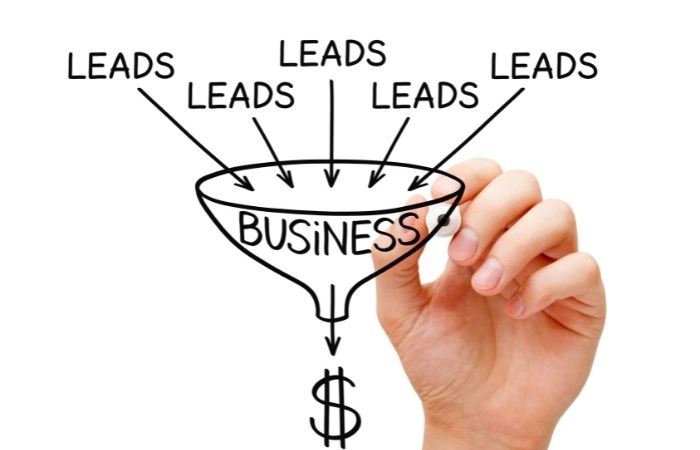
If only there were a way to visualize the entire sales process so that your business could better predict and respond to customer behavior, leading to an increase in your conversion rate and customer retention…
Oh, wait, that already exists?
It’s time your business met its sales funnel.
What is a Sales Funnel, and How Is It Used?
A sales funnel is a virtual representation of a potential customer’s pathway toward becoming a bona fide customer. Digital marketers like the analogy of a funnel because it describes how deft marketing, comprising well-positioned content and well-timed outreach, focuses on a customer’s intent toward conversion.
Much in the way that a funnel focuses whatever passes through it toward a well-defined point, your business marketing funnel focuses potential customers toward converting.
Why Should Business Owners Understand Their Sales Funnel?
It’s one thing to grasp the analogy loosely—that’s easy enough. It’s another thing entirely to use the sales funnel model effectively and multiply your conversion rate in the process.
The true value of understanding your business’s sales funnel is that it gives you incredible insight into the holes in your own marketing approach. By scrutinizing where, why and how potential customers fall through the cracks in your funnel, you can better address those issues and improve the efficacy of your marketing efforts.
How Are Sales Funnels Structured?
There are many versions of the sales funnel—some are specific to certain industries and niches, while others have been adopted beyond traditional marketing and applied to other social sciences.
However, for the purposes of this article, we will explore the basic, vanilla version of the sales funnel (because we have to start somewhere). Digital marketers have broken the sales funnel into four primary phases, affectionately acronymized as AIDA.
- The Awareness Phase
- The Interest Phase
- The Decision Phase
- The Action Phase
Since the inception of this model, marketers have made many modifications, adjustments, and additions to the four steps. However, to keep things streamlined, let’s stick to the original four.
1. Awareness
This phase begins the moment a customer becomes aware of your brand. They may not need your goods or services yet, but they have just passed through the wide end of the sales funnel. Maybe they discovered your brand through word of mouth—the best kind of marketing—or perhaps they saw a commercial, read a social media post shared by a friend, or happened upon some content your business produced.
During this stage, your business’s goal isn’t necessarily to snatch up the customer, hook, line, and sinker. Instead, your business should be more concerned with establishing your brand as a source of authority regarding your good or service.
2. Interest
Though direct advertising through commercials, billboards, and social media ads is definitely a part of the interest stage, the goal of any content marketing you produce for this stage should be to establish brand authority over a specific topic. You need to position your brand as somehow offering more than your direct competitors.
For example, if you own a camping gear manufacturing company, you can get customers to enter the awareness phase through traditional forms of advertising. But, to garner interest, it also makes sense for you to produce content that positions your brand as an authoritative source for all things camping—products, information, tips, and locations.
By doing this, you associate your brand with all things camping and establish your brand as an authoritative source for consumers. Of course they are going to buy your winter sleeping bag! They learned about how to camp in the winter from reading your extensive blog.
You still aren’t directly selling your good or service to the customer. The goal here is to position your brand as the obvious best choice.
3. Decision
When it comes time for the customer to decide—let’s stick with picking a winter-proof sleeping bag—they will likely have narrowed down their decision to a few options. You’ve already positioned your brand as a source of authority. The potential customer already trusts your brand enough to frequent your blog for tips, suggestions, and advice.
To help crystalize their decision, you’ll want to sweeten the deal even more. Perhaps your business has established a reward system, offers specific discounts to avid blog readers, or incentivizes customers to take pictures with your camping products and post them on social media for additional rewards.
These are examples of additional perks you can offer your potential customers to make them more likely to become actual customers.
4. Action
This is the point of conversion. However, your job doesn’t end with purchasing a single sleeping bag. You want to keep your new customer engaged, so they come to you for all of their camping needs.
This is where the benefit of having a solid email marketing system, customer loyalty rewards system, and other perks helps you retain your customers.
How To Build Your Own Sales Funnel
Now, are you starting to see the benefit of implementing the sales funnel model into your marketing plan?
It’s easy to read an article online detailing a sales funnel and how to use it. What’s harder is figuring out your own.
To get started, ask yourself the following questions.
Who Are You?
Not in an existential sense… You need to establish a brand identity. This identity needs to be structured so that it resonates with a wide swath of segments of your target audience.
Who Is Your Target Customer?
This means you also need to know who you are going after. For most businesses, there is not ONE answer to this question. A commercial real estate investment firm may try to target people with higher incomes, but within that field, there are a dozen of demographics that have their own wants and needs. Figuring out your brand goes hand in hand with knowing who you want to attract to your goods or services.
Remember, Your Sales Funnel Is A Work In Progress
An interesting facet of the sales funnel is that you can make real-time adjustments to it and track the success and failures of your marketing approach. You shouldn’t look at your sales funnel as a set-it-and-forget-it kind of process. Rather, you need to see it as a feedback loop that you can hone and improve over time.
This is a process, and you will make mistakes. But you need to learn from these mistakes to create a more effective sales funnel.
About the Author

Jenn Walker is a freelance writer, blogger, dog-enthusiast, and avid beachgoer operating out of Southern New Jersey.


